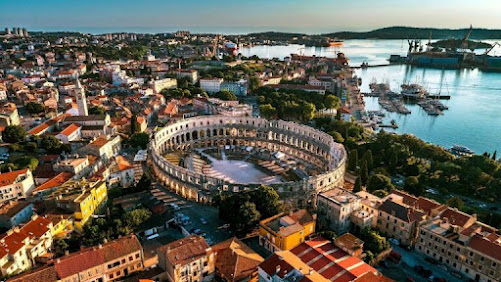"The pastel-colored seaside
towns of Istria could be straight out of Liguria; the rustic hill towns
are reminiscent of Umbria. Istria is rich in vineyards and olive groves,
and wine and olive oil, along with truffles, are the most prominent
exports. And yet Istria remains relatively undiscovered."
-- Kate McCulley
========================================================================
(in
western Croatia) Situated at the southern tip of the Istrian Peninsula,
the city of Pula is known for its multitude of ancient Roman buildings,
the most famous of which is the Pula Arena, a well-preserved
Roman amphitheaters. The city has a long tradition of wine making,
fishing, shipbuilding, and tourism. (It was the administrative center of
Istria from ancient Roman times until superseded by Pazin in 1991.)
Lying at the southern tip of Istria, at the head of the Bay of Pula the
city has a large, almost landlocked harbor, in which there is a naval
base and the Uljanik shipyards.
+ Conquered by Rome in the 2nd century BCE, Pula by the 2nd century CE was the seat of a Christian bishop, and in later centuries it was part of the territories of Byzantium, of the Franks, and of Venice. In 1380 the Genoese exacted revenge raids on Pula. For some 400 years Pula declined in importance, until the 19th century. Plagues drastically reduced the population in the 1630s. Austria took the town in 1797; after 1866 it became the main harbor and arsenal of the Austro-Hungarian navy.
+ After World War I, Pula (and Istria) became part of Italy and the majority of Croatians suffered oppression during this time as their rights were not respected. After World War II ended in 1945, Pula was administered by the United Nations and British and American units. It passed to Italy in 1920 and after 1947, became part of Croatia (in what was Yugoslavia at the time). Since the collapse of Yugoslavia in the early 1990s, Pula has been part of the Republic of Croatia since 1991.
+ Pula's most famous attraction, the well preserved Roman amphitheater, is one of the most famous sights in the whole of Croatia. (A temple of Augustus and a Byzantine basilica were extensively restored after the destructive conflict between Genoa and Venice.) TheTriumphal Arch of the Sergii was built between 29 and 27 BC in honor of the Sergi family who fought on the side of Octavian, who later became Emperor Augustus, in the Battle of Actium in present-day Greece. The Kaštel, on the hill at the center of the Old Town, is a museum (and was previously a fortress).
+ Historical attractions aside, however, Pula is quite a busy commercial city by the sea that has retained a friendly small-town appeal. Just a short bus ride away, a series of beaches awaits visitors at the resorts that occupy the Verudela Peninsula to the south. (The coast is dotted with fragrant pine groves, seaside cafes, and restaurants.)
+ Pula is also a great base for exploring the protected Cape Kamenjak nature park, to the south, and the Brijuni Islands National Park, to the north.





No comments:
Post a Comment